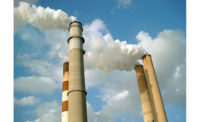The Biden administration released a rule aimed at reducing methane emissions from American oil and gas sources on the same day the U.S. and European Union announced at the COP26 climate summit in Scotland that 90 countries have joined the Global Methane Pledge, which aims for a 30% methane emissions cut by 2030.
The proposed rule, announced Nov. 2 by the U.S. Environmental Protection Agency, seeks to regulate both new and existing sources of methane emissions from the oil and natural gas sector. It aims to decrease methane emissions by 41 million tons between 2023 and 2035, equivalent to 920 million metric tons of carbon dioxide.
By 2030, reductions in methane emissions from sources under the rule would be lower than 74% of the 2005 level, according to EPA. While it stays in the atmosphere for a shorter period than CO2, methane is a much more potent greenhouse gas, responsible for trapping 80 times the amount of heat in the atmosphere compared with CO2 over a 20-year period.
Key features of the EPA proposal include monitoring for leaks at both new and existing well sites and compressor stations; an option for owners and operators to comply by using cost-reducing advanced technology to discover leaks; a zero-emissions standard for new and current pneumatic controllers; and standards to eliminate gas venting and address emissions from storage tanks, pneumatic pumps, compressors and other sources.
Methane emission controls for new or modified facilities were first mandated by the Obama administration, then rescinded in the Trump administration, but restored earlier this year by congressional Democrats using a legislative mechanism to negate the Trump action.
“By building on existing technologies and encouraging innovative new solutions, we are committed to a durable final rule that is anchored in science and the law, that protects communities living near oil and natural gas facilities, and that advances our nation’s climate goals under the Paris Agreement,” said EPA Administrator Michael S. Regan in a statement.
Separately, the U.S. Transportation Dept. issued final rules on Nov. 2 that extend federal safety requirements, design and construction standards and leak incident reporting to an estimated 400,000 miles of previously unregulated “gathering” lines, mostly in rural areas, that carry gas from wells to central hubs. The Interior Dept. meanwhile is set to propose rules on gas flaring and venting for oil and natural gas wells on federal lands, which the agency says made up 7.6% of the U.S. oil supply and 9.1% of its gas production last year.
Global Responses
In its Global Methane Assessment released in May, the UN found the fossil fuel sector has the “greatest potential for targeted mitigation” in the next decade, and said that up to 80% reduction measures for oil and gas emissions and up to 98% of those for coal emissions “could be implemented at negative or low cost.”
The report said that “lower methane concentrations would rapidly reduce the rate of warming, making methane mitigation one of the best ways of limiting warming in this and subsequent decades.”
The global pledge asks signatories to work toward the 2030 methane emissions cut by addressing a variety of sources that include agriculture and waste-related emissions in addition to oil, gas and coal. It also asks countries to improve how emissions are measured.
Frank Macchiarola, American Petroleum Institute senior vice president for policy, economics and regulatory affairs said in a statement that the group supports “the direct regulation of methane from new and existing sources and [is] committed to building on the progress we have achieved in reducing methane emissions.” Calling the EPA proposal “sweeping,” he said API “looks forward to reviewing it in its entirety.”
While oil and gas sector sources of methane have taken steps to cut methane emissions partially owed to new pressure from investors, some predict lawsuits against the rule, ENR reported earlier this year.
Sen. Shelley Moore Capito (R-W.Va.), ranking member of the Senate Environment and Public Works Committee, termed the proposed rule “yet another attack on U.S. energy,” in a statement.
While calling the rule proposal a “critical step” that would “achieve real benefits by slashing oil and gas methane emissions significantly,” Kelly Sheehan, Sierra Club senior director of energy campaigns, said in a statement that “a more ambitious target is achievable,” noting that “the proposal would allow a large number of wells to forgo regular inspections to detect and repair leaking equipment, and would not stop oil wells from flaring gas on a routine basis.”
EPA is holding a 60-day comment period for the rule, published in the Federal Register on Nov. 2.







Post a comment to this article
Report Abusive Comment